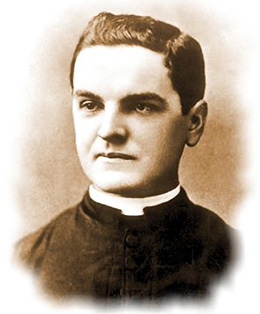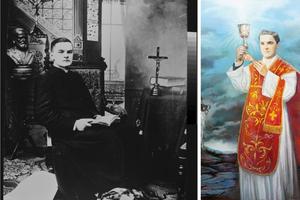Father McGivney’s Niagara Days and the American Sublime
What was it that drew Father McGivney, founder of the Knights of Columbus, to a seminary near Niagara Falls?


Although Father McGivney was from Connecticut, he didn’t begin his priestly formation in his diocese, or even in the United States — he enrolled at Sainte-Hyacinth Seminary in Quebec, where he remained only one year before returning to his home state. However, within a year he had decided to enroll at Our Lady of Angels Seminary at Niagara College (now Niagara University) for reasons that even his official biographers, Douglas Brinkley and Julie M. Fenster in their book Parish Priest, don’t quite know.
While we can’t be sure exactly why McGivney chose Niagara as his course of study, we do know for a fact that Our Lady of Angels/Niagara College was assiduous in its student/seminarian marketing campaign — at a time when “marketing campaigns” were still very nebulous.
To attract students to the newly-founded (in 1856) Niagara College/Our Lady of Angels Seminary, the school, run by the Vincentians (both then and now) emphasized to the prospective students and seminarians the proximity of the college to Niagara Falls.
Why is this important? Many reasons. For one, Niagara Falls was the epitome or icon of “The American Sublime” — that is, that “America the Beautiful” bore witness to the power of God Himself.
In the words of the great doctor of the Church, St. Augustine of Hippo, “The beauty of creation bears witness to God.”
It should be remembered that in 1871, the year McGivney entered Our Lady of Angels Seminary at Niagara, America was an incredibly different place from what it is today in many ways. For one, there were only 38 states, and most of the west was made up of unsettled “territories.” For another, the entire South was still reeling from the effects of the Civil War. And American Catholics were generally viewed not as patriots, but as vaguely un-American immigrants. The thought of five Supreme Court justices being Catholic (as is the case today) would have been laughable to anyone in 1871.
Further, while America was indeed a beautiful place and peppered with already ancient universities (Harvard and William and Mary went as far back as the mid-17th-century), only Niagara Falls was (a) accessible, (b) safe, (c) international — with Canada just a bridge or boat away, (d) settled, and (e) still relatively unspoiled.
We know that Father McGivney enjoyed the outdoors and Niagara College, in addition to having an active intramural baseball league in which he participated, would have appealed to his love of nature, as the Lower Niagara River runs right in front of Niagara College. So with some hiking gear and some brave companions, McGivney could climb to the base of the Niagara Gorge and view God’s grandeur in the Lower Niagara River rapids.
But it’s here that we have to take the totality of area into consideration, as people in the 1870s were accustomed to walk anywhere from 15 to 18 miles a day for both transportation and recreation. Niagara Falls itself is only five miles from Niagara College. The massive Niagara Whirlpool — another wonder of the world in its own right — is less than three miles from the campus. The Niagara’s Upper Rapids connect to Lake Erie only 20 miles to the south in Buffalo. From Niagara College to Lake Ontario is about 15 miles.
And this was before all of the above was ruined by hydroelectric plants, giant chemical conglomerates, and massive power projects on both sides of the border. Today we see maybe 70% of the water going over Niagara Falls: in McGivney’s day he would have seen Niagara Falls in its full-blast splendor.
While all United States college campuses are lovely — one need only think of the time Thomas Jefferson took on painstakingly planning out his University of Virginia — only Niagara could rightly claim that it was actually a part of the American Sublime. And it did make that claim to possible students and seminarians.
We don’t know if that’s why McGivney chose Niagara but it certainly explains how a tiny one-building college quickly grew to be both an accredited college and seminary at a time when American had only one cardinal.
We also do not know why McGivney spent only one year at Niagara before going back home to Connecticut and then transferring to St. Mary’s in Montreal with the Society of Jesus. However, we do know for a fact that the winter that McGivney spent at Niagara College was one of the worst, if not the worst, in recorded history. And even though Our Lady of Angels had built up rapidly several formidable buildings since its founding 15 years earlier, it’s no use to think that heating these stone-and-brick monoliths was as easy as turning a dial on a thermostat or clicking the climate control button. In short, it would have been brutally cold.
We also do know that the ice, which would have formed initially in Lake Erie in November, would have eventually gone over the Falls and then jammed up the lower Niagara River — right in front of Niagara College — as late as May or even June, keeping temperatures absurdly low well into spring and early summer.
While soon-to-be-Blessed Michael McGivney did not graduate from Niagara University or its Our Lady of Angels Seminary, the imprint of the Vincentian Mission to the poor, orphan, widowed, marginalized and outcast is evident in the work that he went on to do in founding the Knights of Columbus — a fraternal organization that ministers to all of these groups. St. Vincent de Paul (and Niagara University) would be, and are rightfully, proud of him!
- Keywords:
- father michael mcgivney
















